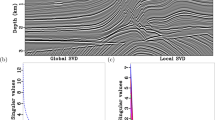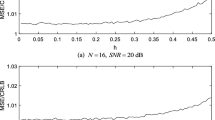Abstract
In this paper, the weak derivatives (WD) criterion is introduced to solve the frequency estimation problem of multi-sinusoidal signals corrupted by noises. The problem is therefore modeled as a new least squares optimization task combined with WD. To overcome the potential basis mismatch effect caused by discretization of the frequency parameters, a modified orthogonal matching pursuit algorithm is proposed to solve the optimization problem by coupling it with a novel multi-grid dictionary training strategy. The proposed algorithm is validated on a set of simulated datasets with white noise and stationary colored noise. The comprehensive simulation studies show that the proposed algorithm can achieve more accurate and robust estimation than state-of-the-art algorithms.




Similar content being viewed by others
References
D. Brewer, M. Barenco, R. Callard, M. Hubank, J. Stark, Fitting ordinary differential equations to short time course data. Philos. Trans. R. Soc. A 366, 519–544 (2008)
A.E. Brito, C. Villalobos, S.D. Cabrera, Interior-point methods in l(1) optimal sparse representation algorithms for harmonic retrieval. Optim. Eng. 5, 503–531 (2004)
C. Cai, K. Zeng, L. Tang, D. Chen, W. Peng, J. Yan, X. Li, Towards adaptive synchronization measurement of large-scale non-stationary non-linear data. Future Gener. Comput. Syst. 43–44, 110–119 (2015)
C. Candan, Analysis and further improvement of fine resolution frequency estimation method from three DFT samples. IEEE Signal Process. Lett. 20, 913–916 (2013)
P. Dash, S. Hasan, A fast recursive algorithm for the estimation of frequency, amplitude, and phase of noisy sinusoid. IEEE Trans. Ind. Electron. 58, 4847–4856 (2011)
S. Djukanovic, An accurate method for frequency estimation of a real sinusoid. IEEE Signal Process. Lett. 23, 915–918 (2016)
M. Geng, H. Liang, J. Wang, Research on methods of higher-order statistics for phase difference detection and frequency estimation, in 2011 4th International Congress on Image and Signal Processing (IEEE 2011), pp. 2189–2193
Y.Z. Guo, L.Z. Guo, S.A. Billings, H.L. Wei, Ultra-orthogonal forward regression algorithms for the identification of non-linear dynamic systems. Neurocomputing 173, 715–723 (2016)
R. Jennrich, Asymptotic properties of the nonlinear least squares estimators. Ann. Math. Stat. 40, 633–643 (1969)
T. Jin, S. Liu, R. Flesch, Mode identification of low-frequency oscillations in power systems based on fourth-order mixed mean cumulant and improved TLS-ESPRIT algorithm. IET Gener. Transm. Dis. 11, 3737–3748 (2017)
D. Kundu, A. Mitra, Genetic algorithm based robust frequency estimation of sinusoidal signals with stationary errors. Eng. Appl. Artif. Intell. 23, 321–330 (2010)
D. Kundu, S. Nandi, Parameter estimation of chirp signals in presence of stationary noise. Stat. Sin. 18, 187–201 (2008)
D. Kundu, S. Nandi, Determination of discrete spectrum in a random field. Stat. Neerl. 57, 258–283 (2003)
S. Liu, Y. Zhang, T. Shan, R. Tao, Structure-aware Bayesian compressive sensing for frequency-hopping spectrum estimation with missing observations. IEEE Trans. Signal Process. 66, 2153–2166 (2018)
B. Mamandipoor, R. Dinesh, M. Upamanyu, Frequency estimation for a mixture of sinusoids: A near-optimal sequential approach, in IEEE Global Conference on Signal and Information Processing (IEEE, 2015), pp. 205–209
B. Mamandipoor, D. Ramasamy, U. Madhow, Newtonized orthogonal matching pursuit: frequency estimation over the continuum. IEEE Trans. Signal Process. 64, 5066–5081 (2016)
U. Orguner, C. Candan, A fine-resolution frequency estimator using an arbitrary number of DFT coefficients. Signal Process. 105, 17–21 (2014)
D. Ramasamy, S. Venkateswaran, U. Madhow, Compressive parameter estimation in AWGN. IEEE Trans. Signal Process. 62, 2012–2027 (2014)
P. Rodriguez, A. Tionbus, R. Teodorescu, M. Liserre, F. Blaabjerg, Flexible active power control of distributed generation systems during grid faults. IEEE Trans. Ind. Electron. 54, 2583–2592 (2007)
S. Sahnoun, E.H. Djermoune, C. Soussen, D. Brie, Sparse multidimensional modal analysis using a multigrid dictionary refinement. EURASIP J. Adv. Signal Process. 12, 1–10 (2012)
M. Schmidt, H. Lipson, Distilling free-form natural laws from experimental data. Science 324, 81–85 (2009)
Z. Shi, F. Fairman, Harmonic retrieval via state space and fourth-order cumulants. IEEE Trans. Signal Process. 42, 1109–1119 (1994)
R. van Vossen, H. Naus, A. Zwamborn, High-resolution harmonic retrieval using the full fourth-order cumulant. Signal Process. 90, 2288–2294 (2010)
A. Walker, On the estimation of a harmonic component in a time series with stationary independent residuals. Biometrika 58, 21–36 (1971)
C. Wu, Asymptotic theory of the nonlinear least squares estimation. Ann. Stat. 9, 501–513 (1981)
S. Yang, H. Li, Estimation of the number of harmonics using enhanced matrix. IEEE Signal Process. Lett. 14, 137–140 (2007)
P. Yannis, O. Rosec, S. Yannis, Iterative estimation of sinusoidal signal parameters. IEEE Signal Process. Lett. 17, 461–464 (2010)
M. Zhang, L. Fu, H. Li, G. Wang, Harmonic retrieval in complex noises based on wavelet transform. Digit. Signal Process. 18, 534–542 (2008)
Z. Zhou, S. Cheung, F. Chan, Optimally weighted music algorithm for frequency estimation of real harmonic sinusoids, in IEEE International Conference on Acoustics, Speech and Signal Processing (IEEE, 2012), pp. 3537–3540
Acknowledgements
This work is supported by the open research project of The Hubei Key Laboratory of Intelligent Geo-Information Processing with Grants KLIGIP2016A01 and KLIGIP2016A02, the specific funding for education science research by self-determined research funds of CCNU from the colleges’ basic research and operation of MOE with Grants 230-20205160288 and CCNU15A05022.
Author information
Authors and Affiliations
Corresponding author
Rights and permissions
About this article
Cite this article
Fu, L., Zhang, M., Liu, Z. et al. Robust Frequency Estimation of Multi-sinusoidal Signals Using Orthogonal Matching Pursuit with Weak Derivatives Criterion. Circuits Syst Signal Process 38, 1194–1205 (2019). https://doi.org/10.1007/s00034-018-0906-5
Received:
Revised:
Accepted:
Published:
Issue Date:
DOI: https://doi.org/10.1007/s00034-018-0906-5




